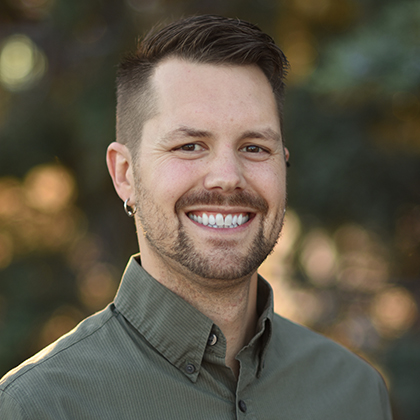Utilizing QR code and GIS technology to connect a mobile generation with the University of Redlands as a biodiverse Tree Campus
Professional Bios:
Dustin VanOverbeke

Dr. Dustin VanOverbeke grew up in a small farming town in southwestern MN where he spent most of his childhood enjoying the outdoors and chasing bugs. He earned his B.S. in Biology with a minor in Environmental Science from the University of Wisconsin, Eau Claire. His undergraduate research studying the effects of elk browsing on forb availability and butterfly diversity inspired him to pursue his PhD in Entomology from the University of California, Riverside. It also inspired him to teach at a small liberal arts institution where he could help undergraduates gain the type of research experience he was so fortunate to have. Dr. VanOverbeke pursues research on insect-plant interactions, specifically with respect to insect nutritional ecology and behavior. He is further interested in insect self-medication in response to parasitism.
James Blauth
 James has done research in ecological restoration of disturbed desert habitats using native woody plants and soil microbes. HIs academic interests include: plant biology, genetics, ecology, and scientific literacy. In spring 2009 Jim and his research team transplanted 60 seedlings into Cottonwood Pass in Joshua Tree National Park to re-vegetate and (hopefully) initiate ecological restoration of a disturbed desert wash.
James has done research in ecological restoration of disturbed desert habitats using native woody plants and soil microbes. HIs academic interests include: plant biology, genetics, ecology, and scientific literacy. In spring 2009 Jim and his research team transplanted 60 seedlings into Cottonwood Pass in Joshua Tree National Park to re-vegetate and (hopefully) initiate ecological restoration of a disturbed desert wash.
Project Summary:
The long-term aim of this project is to utilize the tree biodiversity on our main campus to teach our students and the general public not only to recognize different species, but to recognize the importance of biodiversity. We are developing an interactive campus tree map and having students in multiple courses map out, identify, gather data on, and write "tree biographies" (species accounts) for our campus trees. We plan to continue updating and improving the map as a resource that will be used by multiple majors and non-majors biology as well as for spatial studies, environmental science, and as an open educational resource for outreach to the broader community. For example, students could compete to ‘collect’ the greatest number of species, like one may do in the currently popular Pokémon GO App. With our 2017 faculty technology grant we created a Trees website – through the UoR EpiServer (sites.redlands.edu/trees). We also worked on a visually rich, user-friendly, campus tree map application (https://css-web.redlands.edu/rmap/campustrees/) that users can easily access via their mobile devices while using GPS functionality to see their location on campus. Although we have begun to expand the initial tree map, we plan to complete the mapping of every region of campus. We also continue to update the map to correct cases of misidentified species, remove trees that are no longer on campus, and add newly planted trees. One hundred tree tags (four tags each for 25 species) with QR codes have been purchased so far. Tags for the original nine species described have been placed on representatives around campus in high traffic areas and linked to species accounts. By the end of this semester we will have placed all of the tags with the need to purchase more for additional species. As the database and informational pages grow, we hope to pilot a class activity in which students are assigned sets of GPS coordinates to “collect” species on their list. Spatial coordinates will be associated with trees tagged with QR codes that students scan to access species accounts. Students will report the species found at each location as well as facts about its native range and natural history. Students may also be asked to identify another individual of the species elsewhere on campus and report its location. This will improve knowledge of tree natural history and biodiversity, and give students experience with spatial data and technology by using the interactive campus map and the ArcGIS Collector App. Entomology in Spring 2018 will include a project where students are assigned trees with completed species accounts and QR codes to add sections detailing information about insects associated with the tree species. Plant Ecology in May 2018 will include activities in which students utilize the map and the app to practice field methods in plant ecology research. Students may use marked trees to practice methods in measuring tree size (e.g. height, trunk diameter, and canopy diameter). They may then use these data, paired with information on numbers of that species on campus, to practice estimating total biomass, canopy cover, etc. Trees included in the pre-existing campus tree tour will be marked with QR tags to add to the experience for campus visitors. Currently, those taking the tour are limited to the information located here: http://www.redlands.edu/globalassets/ucomm/www/meet-redlands/docs/campustreetour.pdf. We would like to explore the use of 360° video camera footage to add VR content to the website, allowing visitors to take a virtual tour of some of the trees. We recognize that there is no detailed timeline for this project, since we hope it will be ongoing with further developments in future years. However, we expect to have additional trees mapped, species account webpages built, QR tags linked to those webpages purchased and placed, as well as project assessment via student surveys and deliverables, before June 1st, 2018.


 James has done research in ecological restoration of disturbed desert habitats using native woody plants and soil microbes. HIs academic interests include: plant biology, genetics, ecology, and scientific literacy. In spring 2009 Jim and his research team transplanted 60 seedlings into Cottonwood Pass in Joshua Tree National Park to re-vegetate and (hopefully) initiate ecological restoration of a disturbed desert wash.
James has done research in ecological restoration of disturbed desert habitats using native woody plants and soil microbes. HIs academic interests include: plant biology, genetics, ecology, and scientific literacy. In spring 2009 Jim and his research team transplanted 60 seedlings into Cottonwood Pass in Joshua Tree National Park to re-vegetate and (hopefully) initiate ecological restoration of a disturbed desert wash.